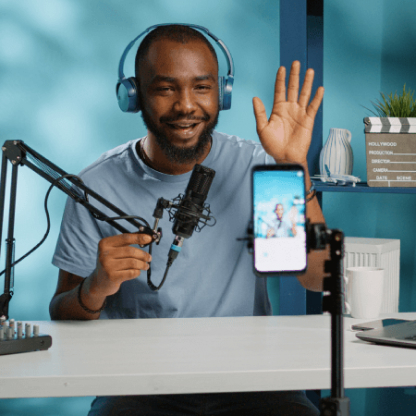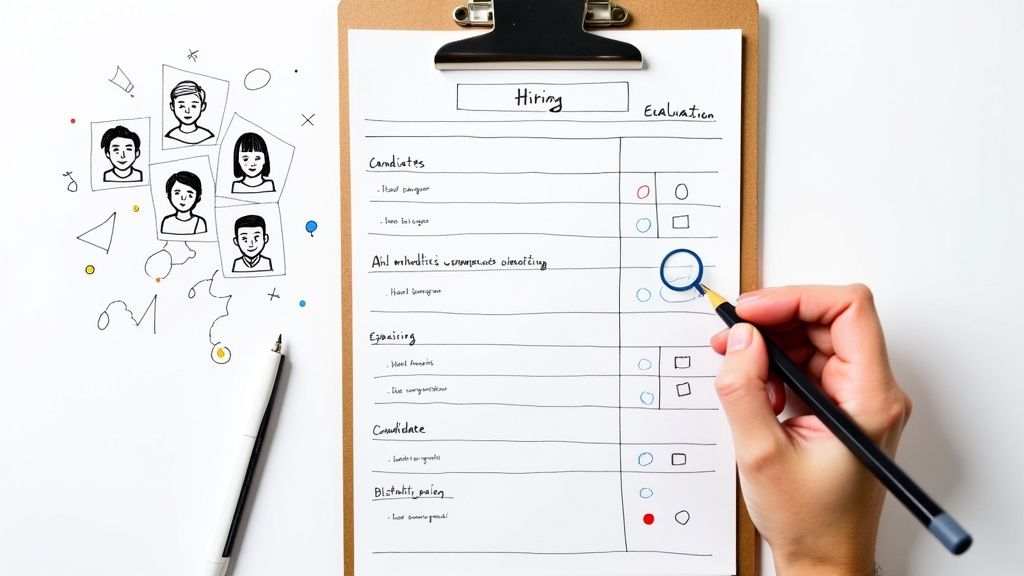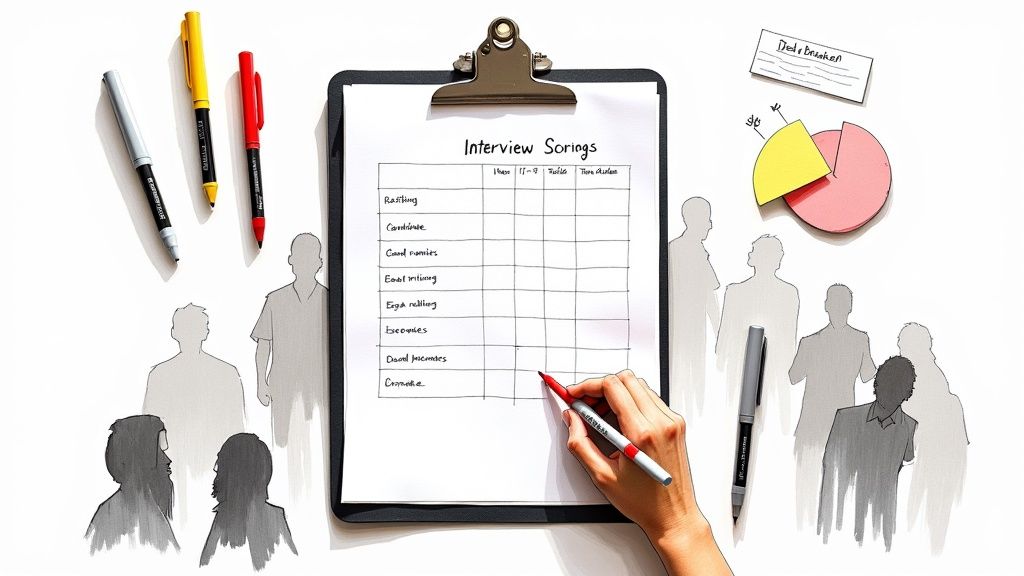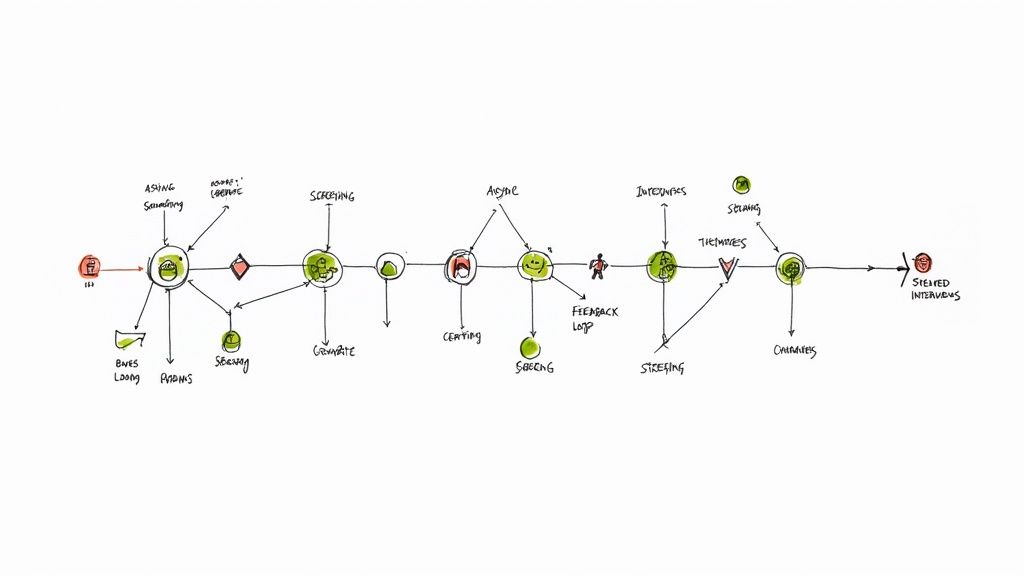Think of a pre-screen interview as the velvet rope for your hiring process. It's a quick, preliminary check designed to answer one brutal question: "Does this candidate meet the absolute minimum requirements to justify a real conversation?"
This isn't the time for a deep dive into their five-year plan or how they handle "constructive feedback." It’s a fast, efficient filter. Period.
The $500 Hello: How to Avoid It
We've all been there. You're five minutes into a formal, hour-long interview, and you already know it's a hard no. The candidate's salary expectations could fund a small startup, or they casually mention they're only open to fully remote work from Bali when the job is hybrid in Boise. It's a colossal waste of time for everyone.
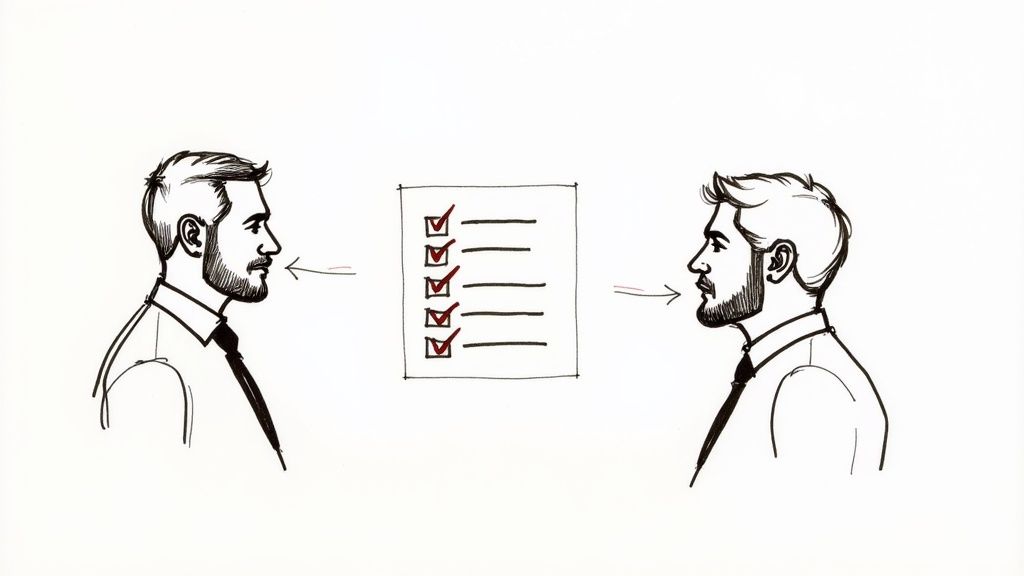
That painful scenario is exactly what a pre-screen interview prevents. Its sole purpose is to get the deal-breakers out on the table before you mortgage your office ping-pong table for a bad hire.
These are your non-negotiables, the stuff you can't budge on:
- Salary Expectations: Are they in the same solar system as your budget?
- Logistics: Can they physically (or virtually) show up to do the work?
- Core Skills: Do they have the one or two skills without which the job is literally impossible?
- Work Authorization: Is this all legal?
Getting these knockout questions answered upfront saves your team from interviewing candidates who were never a viable fit. The numbers back this up. Typically, only about 20% of applicants even make it to a pre-screen. But for those who do, their odds of moving forward skyrocket.
A pre-screen is a rapid data-gathering mission, not a friendly chat. It’s about verifying the black-and-white qualifications before you invest your team's most valuable asset: their time.
This initial check is one of the most powerful ways to focus your energy on actual contenders. When done right, it can drastically reduce time-to-hire and stop your hiring managers from quietly resenting you.
Pre-Screen vs. "Real" Interview: What's the Difference?
It's easy to confuse the two, but their goals are worlds apart. Here’s a quick-and-dirty breakdown of what makes a pre-screen different from a full-blown interview.
| Attribute | Pre-Screen Interview | Formal Interview |
|---|---|---|
| Purpose | To verify basic qualifications and weed out the obvious mismatches. | To assess skills, experience, and cultural fit like you mean it. |
| Length | 15-30 minutes. Tops. | 45-90 minutes, often followed by more… and more. |
| Who's Involved | Usually a recruiter or an HR coordinator. | The hiring manager, team leads, maybe the CEO if you're small. |
| Question Style | Fact-based and direct (e.g., "What's your salary number?"). | Behavioral and situational (e.g., "Tell me about a time you weren't a disaster…"). |
| Goal | To create a shortlist of people who are actually worth interviewing. | To find the one person you're willing to bet your department's budget on. |
Think of it this way: the pre-screen asks, "Can you even do this job?" The formal interview asks, "Should you do this job here, with us?"
Why Your Hiring Process Is Silently Failing You
Let's be honest for a second. Your interview process is probably broken. Most are. They’re slow, wildly inconsistent, and riddled with more unintentional bias than a family Thanksgiving dinner.
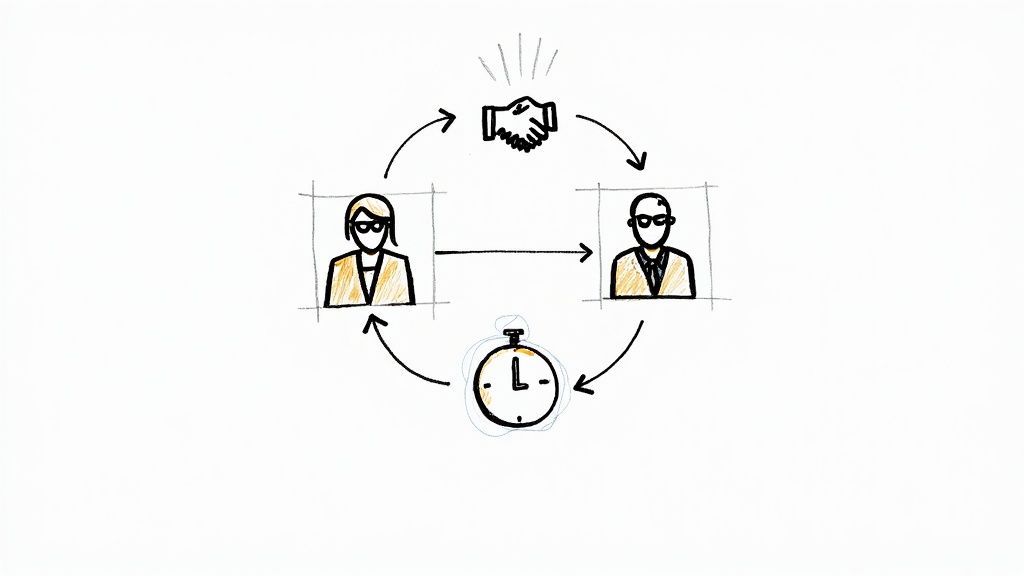
You end up losing great candidates because the whole thing drags on for weeks. Meanwhile, you hire mediocre ones based on "gut feelings" and the sheer exhaustion of sifting through a mountain of resumes that all claim to be "proficient in Microsoft Office." The root cause? Almost always a non-existent or sloppy pre-screening step.
Without a solid pre-screen, you’re just throwing resumes at your team and hoping for the best. This isn't just inefficient—it's actively kneecapping your company.
The Real Cost of a Bad Process
Skipping a proper pre-screen has consequences that ripple through your entire organization. You’re not just wasting time; you’re setting fire to money.
- It burns out your best people. Hope you enjoy paying your senior engineers to talk to people who can't code. Because that’s now their full-time job.
- It infuriates good applicants. Top talent has options. They won't wait around for your disorganized circus. They’ll accept another offer while you’re still trying to schedule a first-round call.
- It leads to catastrophic hiring mistakes. A bad hire can tank team morale and cost you tens of thousands of dollars in lost productivity, training, and the soul-crushing agony of starting all over again.
This isn’t just me ranting. Research shows that one-third of companies lack real confidence in their own interview process. Even more alarming, a staggering 50% admitted to losing top talent because of a poor interview experience. You can discover more insights on hiring challenges and see how common this train wreck is.
Are you in that 50%? Be honest.
Picking the Right Pre-Screening Tool
Alright, so you're sold on pre-screening. Great. Now for the hard part: how do you actually do it without creating a new level of administrative hell? There are a few paths, each with its own set of headaches and rewards. The trick isn't finding a perfect system—it’s finding the one that won't make you want to throw your laptop out the window.
Common Pre-Screening Methods (and Their Flaws)
The old standby is the quick phone call. Simple, right? In theory, yes. In practice, it’s a logistical nightmare of scheduling tag. Get ready for an inbox flooded with "Does Tuesday at 2 PM work?" followed by "Ah, sorry, something just came up…"
Next up, the one-way video interview. You send questions, candidates record answers. Fantastic for scheduling conflicts. The downside? It feels deeply awkward for the person talking to their laptop. You risk filtering for "good at talking to a webcam," which I'm pretty sure isn't a core competency for an accountant.
Finally, there are asynchronous text-based or fully automated platforms. These are brutally efficient, especially for high-volume roles. But if the process feels too robotic, you'll scare off great candidates looking for a human pulse. For a deeper dive, check out our guide on automated candidate screening without turning into Skynet.
The best tool isn't the fanciest one. It's the one that fits your hiring volume, the role's seniority, and how much time your team can realistically burn on this.
To help you decide, let's pit the options against each other.
Comparing Pre-Screening Methods
This table offers a no-BS comparison of the most common methods. Look at it, nod, and pick your poison.
| Method | Pros | Cons | Best For |
|---|---|---|---|
| Phone Call | Feels personal, allows for real-time follow-ups. | A scheduling black hole, ridiculously time-consuming for recruiters. | Low-volume or senior roles where a human touch is non-negotiable from the jump. |
| One-Way Video | High scheduling flexibility, lets you assess communication skills. | Can feel weird and impersonal for candidates, invites tech glitches. | Roles where verbal communication is king and you're hiring across time zones. |
| Automated/Async | Wildly efficient, standardizes the initial screen, great for volume. | Can feel robotic, might filter out great people who are just bad typists. | High-volume roles, entry-level positions, and filtering for hard technical skills. |
Ultimately, each method has its place. Your choice depends entirely on what you're hiring for and how much sanity you have left to spare.
This infographic does a solid job of showing the core differences between a quick pre-screen and a full-on formal interview.
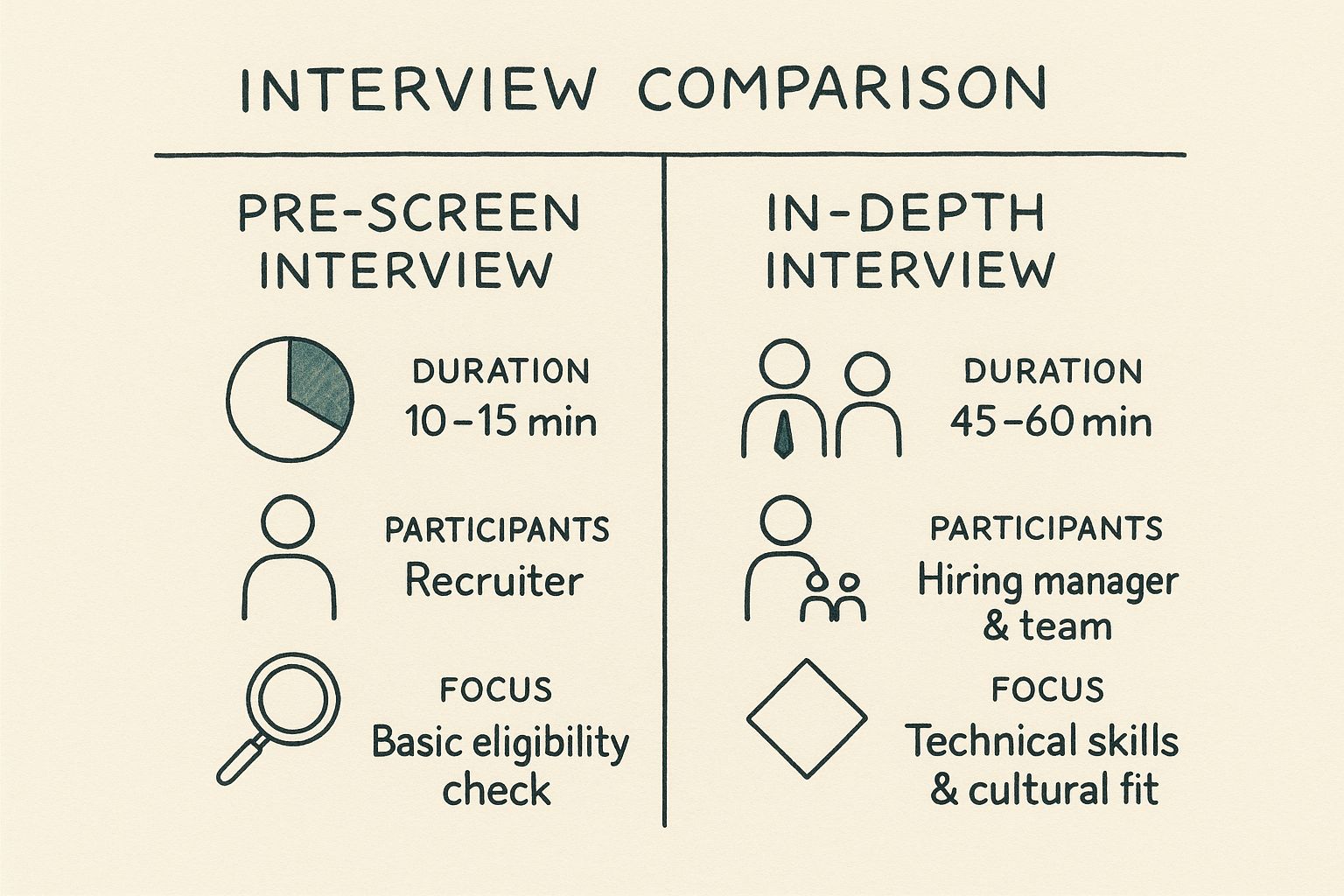
As you can see, pre-screening is all about speed and ticking the boxes. It lets you save the deep, soul-searching evaluation of skills and personality for the few who actually clear that first, merciless hurdle.
Crafting Your Non-Negotiable Questions
This is not the time for softball questions. Forget "What's your biggest weakness?" The pre-screen is for surgical precision, not getting to know someone's childhood pet.
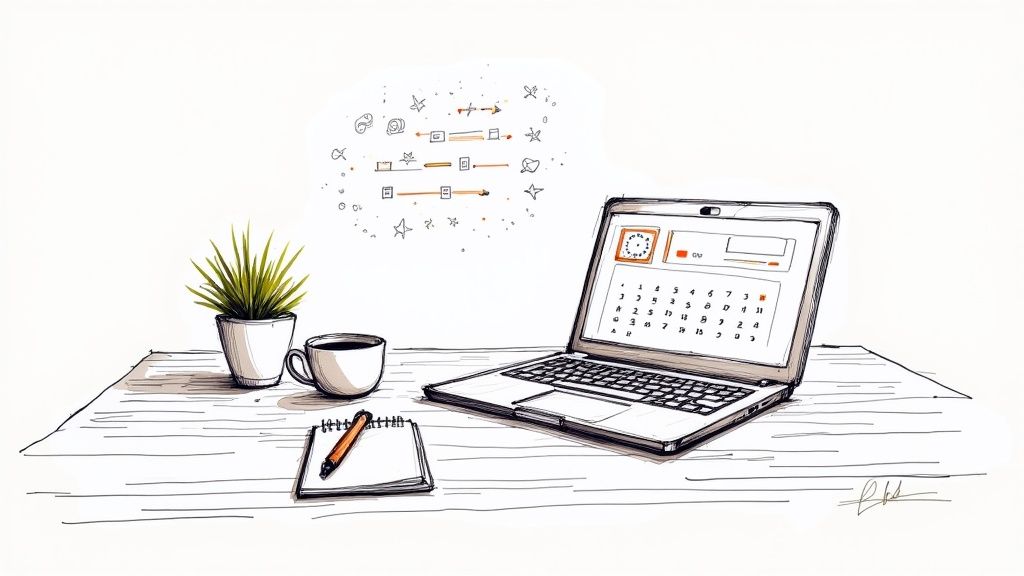
Your goal is ruthless efficiency. You're a bouncer at an exclusive club, not a friendly greeter. The whole point is to filter out the obvious mismatches before they waste your team’s time. This isn’t a chat; it’s a data-gathering mission.
The Big Three Knockout Questions
Before you even think about skills, you need to clear the absolute, no-mercy logistics. I call these the "Big Three," and they should be the first words out of your mouth.
- "What are your salary expectations?" Don't be shy. If their number is double your budget, it’s kinder for everyone to know right now.
- "What are your location or remote work requirements?" If you need someone in the office three days a week and they're in a yurt in Montana, it's a non-starter.
- "When is your earliest possible start date?" You need someone in two weeks, but they can't leave their current job for three months. Deal-breaker.
These questions have binary answers. There’s no gray area. They either align with the role, or they don’t.
If a candidate can't get past these three hurdles, their impressive resume is irrelevant. Getting this info upfront saves everyone from an hour-long interview that was dead on arrival.
Probing for Skills Without the Grind
Okay, logistics check out. Now, confirm they have the core skills. This doesn't mean a full technical grilling. It’s about getting a clear signal with a few sharp questions.
Instead of a vague, "Tell me about your experience with React," which invites a 10-minute monologue, be direct.
Try these instead:
- "Have you built and deployed a production application using React hooks?" This is a yes or a no.
- "On a scale of 1-5, how would you rate your proficiency with SQL?" This gives you a number. Numbers are good.
The key is to frame your questions for a "yes," "no," or a number. Get the facts, make a decision, move on. That’s the art of the pre-screen.
How Asynchronous Interviews Change The Game
Let’s be real, manually pre-screening every applicant is a soul-crushing time sink. It’s a repetitive loop of scheduling, asking the same five questions, and drowning in follow-up emails.
This is where the right tech can save you. Imagine a system that automatically sends your knockout questions to every applicant. Candidates record answers on their own time, and you get a tidy list of people who actually meet your baseline.
That’s the magic of asynchronous interview platforms.
You Are No Longer The Gatekeeper
These tools lift the entire screening burden off your shoulders. You’re no longer chasing applicants or trying to align calendars. The system does it for you. This frees you up to focus on what matters: engaging with qualified candidates.
And yes, this is exactly why we built Async Interview (toot, toot!). We lived the pain of manual screening and knew there had to be a smarter way.
By automating that first touchpoint, you stop being a scheduler and become a strategist. You can dedicate your energy to the high-value work of evaluating top contenders instead of getting stuck in the weeds.
This shift doesn't just make you faster; it makes you better. By standardizing the initial screen, every candidate gets a fair shot. In turn, you get structured, comparable data to make smarter, less biased decisions.
If you're ready to reclaim your calendar, it's worth seeing how you can modernize your recruitment process with on-demand asynchronous interviews.
Sidestepping Common Pre-Screen Blunders
Even with the best intentions, a pre-screen can go off the rails. Trust me, I’ve made all the mistakes. The single biggest one? Turning it into a mini-interview.
The second you start asking deep behavioral questions like, “Tell me about a time you overcame a challenge,” you’ve failed. This isn’t a therapy session; it's a quick strike to get essential data. Stick to the facts.
Another classic blunder is being too vague. If salary is a deal-breaker, don't dance around it. Be direct. Ask for a number. Candidates appreciate the clarity, and it saves everyone from a painful surprise later.
Don't Be a Ghost
And then there's the cardinal sin: ghosting. It’s the fastest way to torch your employer brand. An applicant who never hears back is far more likely to leave a nasty review or tell their network you're a mess.
It takes three seconds to send a polite, templated 'no thanks' email. That small gesture preserves your reputation and shows respect for someone's time, no matter how brief.
So, what are the most common pitfalls to avoid?
- Scope Creep: Letting a 15-minute logistics check morph into a 45-minute interrogation.
- Vague Questions: Posing unclear questions that don't get you the simple, factual answers you need.
- The Black Hole: Failing to explain what's next or, even worse, never following up at all.
Remember, the goal is to be ruthlessly efficient while still being human. Get the answers, provide a clear outcome, and move on. This first touchpoint sets the tone, even for the candidates you reject.
Frequently Asked Questions About Pre-Screening
When you start dialing in your hiring process, questions pop up. Let's tackle the most common ones so you can get back to building your team.
How Long Should a Pre-Screen Be?
Short. Really short. If it's a call, 15 minutes is generous. Think of it as a quick sanity check, not a deep dive.
For an asynchronous pre-screen, aim for 5-7 knockout questions. Any more than that, and you’re just creating more work for yourself and annoying the candidate.
Who Should Run The Pre-Screen?
Usually, a recruiter or an HR coordinator. They're the gatekeepers. In a smaller company, the hiring manager might do it.
The important thing is that the screener doesn't need to be a world-class expert on the role. They just need to know the deal-breakers cold.
A pre-screen isn't a final exam. It's the bouncer checking an ID at the door—a quick check to see if someone meets the basic requirements to get in.
Is It Okay to Ask About Salary?
Not only is it okay, it's essential. In fact, finding a salary mismatch is one of the main reasons to do a pre-screen in the first place.
Getting this out of the way early is a sign of respect for everyone's time. It's better to know about a budget mismatch after a 10-minute chat than after three rounds of interviews. Be direct.
Stop wasting time on mismatched candidates. Async Interview automates your pre-screening so you only talk to qualified, aligned applicants. Start your free trial today.
